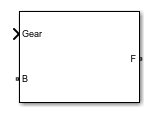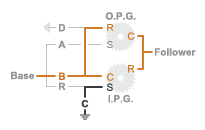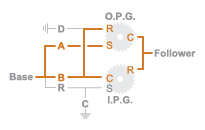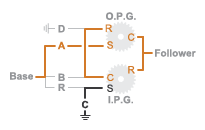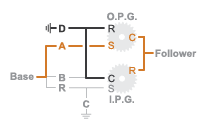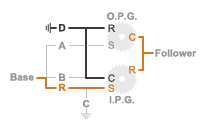4-Speed CR-CR
Clutch schedule for a four-speed carrier ring-carrier ring transmission
Libraries:
Simscape /
Driveline /
Transmissions
Description
The 4-Speed CR-CR block consists of two planetary gear sets and five disk friction clutches. The follower shaft connects to the planet gear carrier of the output planetary gear and the ring gear of the input planetary gear. The clutches are configured to implement four ratios, one reverse ratio, and neutral. The reverse clutch and two of the clutches determine which gears the base shaft connects to. The other two clutches act as brakes, grounding various gears of the planetary sets to the transmission housing.
This diagram shows a four-speed carrier ring-carrier ring transmission. The labels for the gear components are superimposed on the input and output gears. The table lists the gear and clutch components that are labeled in the diagram.
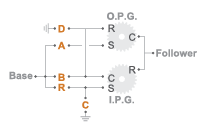
| Label | Component |
|---|---|
| I.P.G. | Input planetary gear |
| O.P.G. | Output planetary gear |
| R | Ring gear |
| C | Planet gear carrier |
| S | Sun gear |
| R | Reverse clutch |
| A–B | Forward clutches that control the power flow path |
| C–D | Forward, braking clutches |
Drive Ratios, Clutch Schedule, and Power Flow
The drive ratio between the transmission input and output shafts follows from the elementary gear ratios specified for the gear blocks. The elementary gear ratios are
and
where:
NRI is the number of teeth in the planetary ring gear on the input shaft side.
NSI is the number of teeth in the planetary sun gear on the input shaft side.
NRO is the number of teeth in the planetary ring gear on the output shaft side.
NSO is the number of teeth in the planetary sun gear on the output shaft side.
The table shows the clutch schedule, drive-ratio expressions, drive-ratio default values, and the power-flow diagrams for each gear of the 4-Speed CR-CR block.
The letters in the clutch schedule columns denote the brakes and clutches. A value
of 1 denotes a locked state and a value of 0
an unlocked state. The clutch schedule generates these signals based on the Gear
port input signal. The signals are scaled through a Gain block and used as actuation
inputs in the clutch blocks.
The power-flow diagrams show the power flow paths between input and output shafts for each gear setting. Power flow is shown in orange. Connections to the transmission housing (a mechanical ground) are shown in black.
| Gear | Clutch Schedule | Drive Ratio Equation | Default Ratio | Power Flow | ||||
|---|---|---|---|---|---|---|---|---|
| A | B | C | D | R | ||||
| 4 | 0 | 1 | 1 | 0 | 0 | 0.67 |
| |
| 3 | 1 | 1 | 0 | 0 | 0 | 1 |
| |
| 2 | 1 | 0 | 1 | 0 | 0 | 1.67 |
| |
| 1 | 1 | 0 | 0 | 1 | 0 | 3 |
| |
| R | 0 | 0 | 0 | 1 | 1 | -2 |
| |
Examples
Ports
Input
Conserving
Parameters
Extended Capabilities
Version History
Introduced in R2015a
See Also
4-Speed Ravigneaux | 6-Speed Lepelletier | 7-Speed Lepelletier | 8-Speed | 9-Speed | 10-Speed
